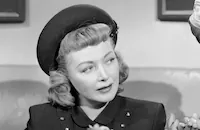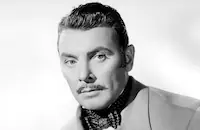Charlie Chan Carries On
Brief Synopsis
Cast & Crew
Hamilton Macfadden
Marguerite Churchill
John Carrick
Warner Oland
Warren Hymer
Marjorie White
Film Details
Technical Specs

Synopsis
Inspector Duff of Scotland Yard gets a call about the murder of wealthy Hugo Morris Drake, who was strangled with a suitcase strap while on an around-the-world tour with a party of other Americans. Dr. Lofton, the tour conductor, discovers that the strap came from his bag. Duff interrogates Walter Honeywood, a theatrical manager occupying the room next to Drake's, who hopes to meet his estranged wife, actress Sybil Conway, at San Remo and persuade her to join him on the trip. Duff then realizes that he cannot hold the twelve remaining tourists because he has no evidence or motive, and after they leave for Paris, Duff learns that Honeywood paid a hotel servant not to reveal that he and Drake exchanged rooms the night Drake was killed. That night, as the party stops over in Nice, a gloved hand fires a shot from some bushes and puts the gun in the hand of the deceased, Honeywood. When Duff arrives the next day, he learns that Honeywood is dead, apparently a suicide. Duff calls Sybil, who meets him at San Remo and says that the murderer is Jim Everhard, a jewel thief to whom she had been unhappily married. Years earlier, when Honeywood and Sybil ran away together, taking two bags of diamonds, Everhard vowed to kill them both. Sybil agrees to point out the killer, but the figure with the gloved hand shoots and kills her. During the next part of the trip, Mark Kennaway, the traveling companion to Patrick Tait, an elderly criminal lawyer, becomes fond of Drake's granddaughter, Pamela Potter, who is continuing the trip to help track down the killer. In Hong Kong, Pam and Mark pass a street merchant who calls out Everhard's name as he passes. When Pam tells the tourist party that Everhard has been spotted, Mark realizes that she has placed herself in danger. As she sends a telegram to Duff, the gloved hand fires a gun at her, but Mark pulls her aside in time. Duff travels to Honolulu, the party's next destination, and after visiting his friend, Inspector Charlie Chan of the Honolulu police, he is shot in the back. Chan prepares to join the party on their voyage to San Francisco, and asks his chief to tell Duff "Charlie Chan carries on." In his cabin on the ship, Chan hears movement by his window and, grabbing a gloved hand holding a gun, pulls the glove off. After clues implicate various male members of the party, the ship approaches San Francisco, and Chan writes identical letters to the suspects. At a party, Chan explains to the guests that Drake was murdered by mistake, for Everhard intended to kill Honeywood. Chan says that in order to save Everhard embarrassment, he has informed him in a note that he will not arrest him until they dock at San Francisco. The tourists then find the letters Chan left for them, while Chan fixes a dummy in front of the window of his own room. As he and Mark wait in the lifeboat, he turns on a switch rigged to light his room. The murderer enters the room and, after shooting at the dummy, is apprehended by Chan and Mark. As the others enter, the murderer is revealed to be John Ross, a limping lumberman who expresses regret over killing Drake, but not Honeywood or Sybil. He then asks Chan how he knew it was him, and Chan reveals that he did not know, but that he wrote the letters to draw the murderer out. Chan then dictates a cable to Duff and, seeing Mark and Pam together, says that they have decided "two shall be one--more later."

Director
Hamilton Macfadden
Cast

Marguerite Churchill
John Carrick

Warner Oland

Warren Hymer
Marjorie White

C. Henry Gordon

George Brent
Peter Gawthorne
John T. Murray
John Swor
Goodee Montgomery
Lumsden Hare
Zeffie Tilbury
Betty Francisco
Harry Beresford
John Rogers
J. Gunnis Davis
James Farley
Crew

Film Details
Technical Specs

Quotes
Trivia
By mid-2003, this was still regarded as a "lost film" with no prints known to exist.
Notes
The above plot was based on a screen continuity in the Twentieth Century-Fox Produced Scripts Collection at the UCLA Theater Arts Library. Earl Derr Biggers' novel was serialized in The Saturday Evening Post (9 August-13 September 1930). Fox also produced a Spanish-language version of this film-see record for Eran trece. In 1940, Twentieth Century-Fox again filmed Biggers' novel as Charlie Chan's Murder Cruise.
"Charlie Chan" first appeared on the screen in a 1926 Pathé serial entitled The House Without a Key, which starred George Kuwa. Universal produced the next Chan film in 1928, entitled The Chinese Parrot, starring Kamiyama Sojin, and in 1929, Fox produced Behind That Curtain, directed by Irving Cummings and starring E. L. Park as the detective. Five of Biggers' six Chan novels were adapted for the screen, while the rest of the Chan films were made from original screenplays. This was the first Chan film to star Warner Oland, who portrayed the detective in sixteen films. After Oland's death in 1938, Sidney Toler took over the lead role in Charlie Chan in Honolulu, released in January 1939. The last Twentieth Century-Fox entry in the series, Castle in the Desert, was released in 1942. Toler, who had bought the screen rights to the Chan character from Biggers' widow, then went to Monogram, which, in 1944, released its first Chan film, Charlie Chan in the Secret Service. Toler continued in the role until his death in 1947, after which Roland Winters played Chan in seven films, beginning with The Chinese Ring in 1947. Monogram ended the series in 1949 with The Sky Dragon.
Keye Luke was featured in several of the Fox and Monogram offerings in the series as "Lee," Chan's "Number One Son," beginning with the 1935 film Charlie Chan in Paris. Sen Yung portrayed "James 'Jimmy' Chan," the detective's "Number Two Son," beginning in 1939's Charlie Chan in Honolulu. (In the Monogram series, Yung was called "Tommy Chan.") Sol Wurtzel produced most of the Fox Chan series, and frequent directors included H. Bruce Humberstone, Eugene Forde, Hamilton MacFadden and Harry Lachman. The Chan character was also portrayed on the radio by Walter Connolly, Santos Ortega and Ed Begley, and on television by J. Carrol Naish and Ross Martin. Keye Luke provided the voice of Chan in The Amazing Chan and the Chan Clan, a Hanna-Barbera cartoon series that ran on CBS from September 9, 1972 to September 22, 1974. In 1976, the Chan character was parodied along with other famous detectives in the Columbia film Murder by Death. The picture, directed by Robert Moore, starred Peter Sellers as "Sidney Wang" and Richard Narita as his son "Willie Wang." With the exceptions of Japanese actors Kuwa and Sojin, who each played Chan once in the 1920s, the detective has been played only by Caucasian actors in American films. Modern sources note that two unauthorized Chan films, featuring Hsu Hsin-yuan, were made by a Chinese company in Shanghai, apparently in the 1930s. Chan's aphorisms were a well-loved component of the films, and a collection of Chan's sayings from the Fox films was published in 1968 under the title Quotations from Charlie Chan. In May 1992, Imagine Entertainment announced that it was preparing a new Charlie Chan film for a 1993 release.












